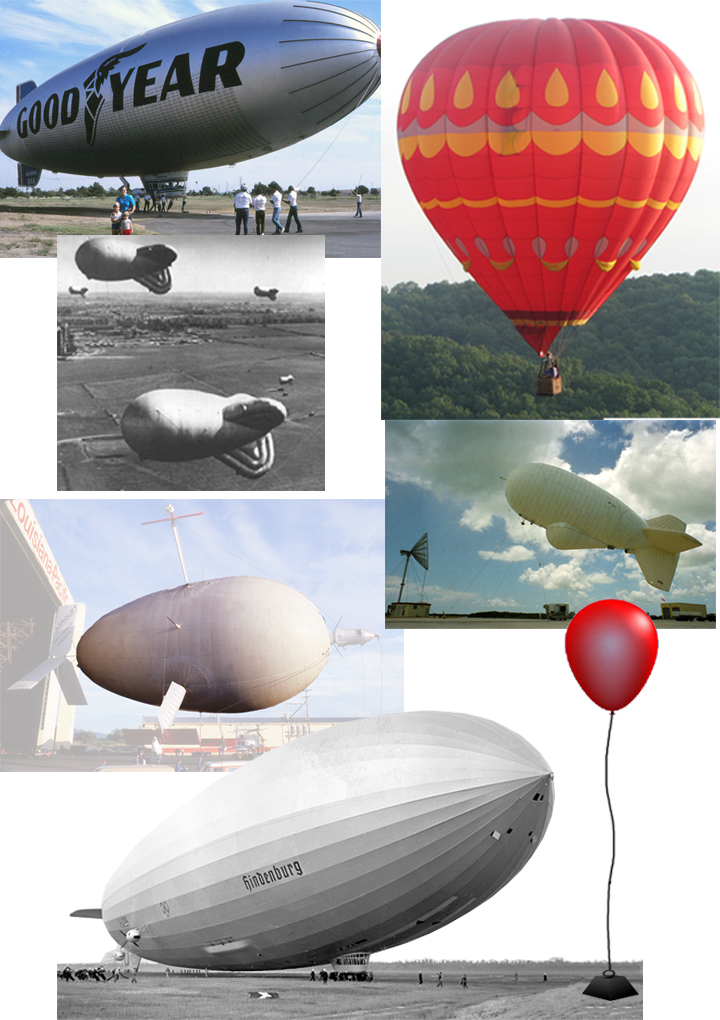
Kite Balloons or Tethered Aerostats
 October 31st, 2013
October 31st, 2013 Robert Crimmins
Robert Crimmins Adventure / Interests / Jobs, Aerostation, Aviation, Engineering, Flying and Floating Machines
Adventure / Interests / Jobs, Aerostation, Aviation, Engineering, Flying and Floating Machines 2 Comments
2 Comments
RCA & GE Aerostat Systems TARS and SBAS Programs
© Robert A. Crimmins, Felton, Delaware, USA
Corporate and military people don’t call them kite balloons. That’s not sexy. To them they’re “aerostats”. Most of us first saw them in World War II newsreels. They were used then to prevent low level strafing and bombing runs and they were called “Barrage Balloons”. But, in the language of “aerostation”, the field of air vehicles and conveyances known as “lighter than air” (LTA), a field related to but distinct from “aviation”, an aerodynamically shaped balloon on a tether is a kite balloon. That’s their proper name.
An “Aerostat” on the other hand is anything that holds a lighter than air gas and can remain at a given altitude, so kite balloons, moored spherical balloons, hot air balloons, and airships such as blimps and dirigibles are all aerostats. So is a child’s toy balloon. Since the Air Force and Army generally prefer technical and masculine terms applied to their systems and products, kite balloons are never called that. To them they are “aerostats”.
I worked on three programs that employed kite balloons. The article on issuu.com (above) is about two of them, TARS or the Tethered Aerostat Radar System and SBAS, the Sea Based Aerostat System. Originally TARS was under Air Defense Command and was used to keep an eye on the Russians as they motored in and out of Cuba but by 1985, when I joined RCA Aerostat Systems, they were used for that and drug interdiction. There were two sites run by the Air Force. The one on Cudjoe Key, one of the Florida Keys, was the one whose radar could see to Cuba. The other site was on Cape Canaveral Air Force Station.
I spent far more time on the Sea Based Aerostat System first as a Quality Control Engineer and then as the Project Engineer.
The third program I was on that employed kite balloons was, the Persistent Threat Detection System and that came far later in my life than the first two. The description of that system and my life when I worked on it is depicted in great deal in my memoir about that period. Some of the chapters from the book are here.
There’s an interesting continuity through the development of TARS, SBAS and PTDS. TARS was the first and it was a product of RCA, the company founded by David Sarnoff and represented by Nipper listening to his master’s voice. When General Electric bought RCA in 1986 it had no effect on the aerostat group, which I joined the year before. We kept doing what we were doing with the only difference being the name. It changed to GE Aerostat Systems. I wasn’t with the company in 1993 when GE Aerospace was sold to Martin Marietta or when Lockheed and Martin Marietta merged, but in both cases the new owners kept the aerostat group. The knowledge base was retained with the most valuable asset for each new entity being the radar systems that the balloons held aloft. The RCA engineers who built the radar for the TARS program were geniuses and their creations were used or adapted to other programs as they were needed.
Floyd Hannaford, who is in the issuu.com article on this page, was a technician on Cudjoe Key in the early years of the TARS program and he was one of the most important men on the Sea Based Aerostat System. His dedication literally saved that program. He remained through all the corporate changes. Being able to work with him again on PTDS was a pleasure.
I worked on three programs that employed kite balloons. The article on issuu.com (above) is about two of them, TARS or the Tethered Aerostat Radar System and SBAS, the Sea Based Aerostat System. Originally TARS was under Air Defense Command and was used to keep an eye on the Russians as they motored in and out of Cuba but by 1985, when I joined RCA Aerostat Systems, they were used for that and drug interdiction. There were two sites run by the Air Force. The one on Cudjoe Key, one of the Florida Keys, was the one whose radar could see to Cuba. The other site was on Cape Canaveral Air Force Station.
I spent far more time on the Sea Based Aerostat System first as a Quality Control Engineer and then as the Project Engineer.
The third program I was on that employed kite balloons was, the Persistent Threat Detection System and that came far later in my life than the first two. The description of that system and my life when I worked on it is depicted in great deal in my memoir about that period. Some of the chapters from the book are here.
There’s an interesting continuity through the development of TARS, SBAS and PTDS. TARS was the first and it was a product of RCA, the company founded by David Sarnoff and represented by Nipper listening to his master’s voice. When General Electric bought RCA in 1986 it had no effect on the aerostat group, which I joined the year before. We kept doing what we were doing with the only difference being the name. It changed to GE Aerostat Systems. I wasn’t with the company in 1993 when GE Aerospace was sold to Martin Marietta or when Lockheed and Martin Marietta merged, but in both cases the new owners kept the aerostat group. The knowledge base was retained with the most valuable asset for each new entity being the radar systems that the balloons held aloft. The RCA engineers who built the radar for the TARS program were geniuses and their creations were used or adapted to other programs as they were needed.
Floyd Hannaford, who is in the issuu.com article on this page, was a technician on Cudjoe Key in the early years of the TARS program and he was one of the most important men on the Sea Based Aerostat System. His dedication literally saved that program. He remained through all the corporate changes. Being able to work with him again on PTDS was a pleasure.
























2 comments
Finally get to see some pictures of the Atlantic Sentry!
I was only a gopher at Steiner Marine Coorporation, but I did get to help out on it!!
That is all.
Rad Duke
The shipyard is mentioned in the article but not named. Steiner Marine Corporation of Bayou La Batre, owned by Ron Steiner, was a good place to work. Ron and his employees were excellent people and good ship builders. RCA didn’t hire them to build the boats that were made when we won the follow on contract, which was a shame.
Leave a comment